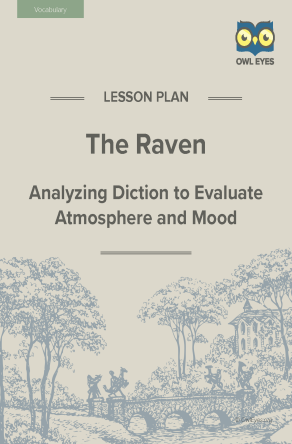The Raven Vocabulary Lesson Plan
- 17 pages
- Subject: Setting, Tone, Vocabulary, Lesson Plans and Educational Resources
- Common Core Standards: RL.9-10.1, RL.9-10.4, SL.9-10.1
- Grade Levels: 6, 7, 8, 9
Additional The Raven Resources
Product Description
Analyzing Diction to Evaluate Atmosphere and Mood in "The Raven”
This lesson plan focuses on Poe’s diction and how it contributes to atmosphere and mood in "The Raven.” Students will examine the connotations of descriptive words in the poem and identify the atmosphere and mood they create in the text. By studying Poe’s diction, students will be better able to describe the setting of the poem, the mysterious raven, and the emotions they evoke in readers.
Skills: close reading, interpreting connotative meaning, drawing inferences from the text
Learning Objectives: By the end of this lesson, students will be able to
- identify characteristics of gothic literature.
- describe the setting of the poem and the narrator’s characterization of the raven.
- define diction, denotation, and connotation and identify the connotations of key words in the poem.
- define atmosphere and mood and describe them in the poem.
- explain how Poe’s diction contributes to the poem’s atmosphere and mood.
About This Document
Owl Eyes lesson plans have been developed to meet the demanding needs of today’s educational environment and bridge the gap between online learning and in-class instruction. The main components of each plan include the following:
- An introduction to the text
- A step-by-step guide to lesson procedure
- Previous and following lesson synopses for preparation and extension ideas
- A collection of handouts and worksheets complete with answer keys
Each of these comprehensive, 60-minute plans focus on promoting meaningful interaction, analytical skills, and student-centered activities, drawing from the Common Core Standards for English Language Arts and the expertise of classroom teachers.
Introduction to the Lesson
When “The Raven” was published in 1845, it launched Edgar Allan Poe to literary fame and critical acclaim he had not previously enjoyed.
Subsequent publications of the poem during Poe’s lifetime also received high praise. Between 1845 and 1849, several critics called it the best American poem ever written. A review by John Moncure Daniel, appearing in an 1849 Richmond Examiner article a month before Poe’s death, praised the poem’s “strange, beautiful and fantastic imagery” and its “musicality.” “The Raven,” Daniel said, is a “work of pure art.” With its iconic haunting mood, the raven’s mysterious presence, and the narrator’s overwhelming melancholy and emotional unraveling, “The Raven” remains Poe’s most popular poem and a celebrated work of gothic literature within the American literary canon.
“The Raven” is a quintessential story of grief. The narrator, trying to distract himself from the melancholy he feels for his deceased love, Lenore, studies late into a dark, dreary December night. At the sound of a tapping on his window, he opens it; a “stately” raven enters his chamber and, perching on a bust of Pallas Athena, regards him with an unwavering gaze. To quell his loneliness and despair, the narrator attempts to engage the bird in conversation, primarily about Lenore, but the raven responds to his questions by uttering only the word “nevermore.” On a deeper level, the poem examines the effects of profound grief on the human psyche. As his encounter with the raven continues, the narrator becomes frantic and increasingly unhinged, mentally and emotionally, until he is ultimately overwhelmed and paralyzed by his grief, with no hope of escaping it.
As Daniel noted in his review of “The Raven,” the poem is musical. Its musicality is created through Poe’s poetic discipline in adhering consistently to the same meter and end rhyme scheme that become almost hypnotic as one stanza follows another. The effect is heightened by other sound devices Poe employs, primarily alliteration, internal rhyme, repetition, and the poem’s unforgettable refrain, “Nevermore.” As Daniel also noted, the poem is one of rich images, both beautiful and strange. Through the musicality and the imagery in “The Raven,” Poe draws readers into the narrator’s tortured emotional state and the haunting atmosphere and mood of the poem.
A work of gothic literature, a popular genre which developed from romanticism in the 19th century, “The Raven” features numerous characteristics of a gothic tale: a gloomy setting, death, madness, mystery, strangeness, and the supernatural. The poem endures, however, as an examination of a universal human experience: the loss of one who was deeply loved.
Worksheet Excerpt
Examining Atmosphere in “The Raven”
Focus on stanzas 1-5 in completing this handout. Discuss the questions as a group, with your group’s recorder writing down the answers on his or her handout. Monitor the answers as the recorder writes them down to make sure they accurately and thoroughly express the thinking of your group.
-
What is the setting of the poem, time and place? What would you see and hear if you were there with the narrator?
-
What are some connotations of these words and phrases Poe chose to use in the first five stanzas? Are the connotations of each one positive or negative?
[Table included for student work]
- Sum it up: How would you describe the setting’s atmosphere created by Poe’s diction in the first five stanzas?







